- Home
- News Releases
- Back Issues
- August FY2022
- Results of FY2021 E-Commerce Market Survey Compiled
Results of FY2021 E-Commerce Market Survey Compiled
August 12, 2022
The Ministry of Economy, Trade and Industry (METI) conducted the FY2021 E-Commerce Market Survey to analyze the current state of the Japanese e-commerce (EC) market. It has now compiled the results into a report.
1. Summary of the survey results
(1) Scale of the domestic EC market (business-to-consumer [B-to-C] and business-to-business [B-to-B])
In 2021, the scale of the domestic B-to-C EC market increased to 20.7 trillion yen (up by 7.35% from 19.3 trillion yen in the previous year, and 19.4 trillion yen in the year before). In addition, the scale of the domestic B-to-B EC market increased to 372.7 trillion yen (up by 11.3% from 334.9 trillion yen in the previous year, and 353.0 trillion yen in the year before).
The scales of the domestic B-to-C and B-to-B EC markets were 19.4 trillion yen and 350.0 trillion yen in 2019, respectively. We can evaluate that the scales in 2021 exceeded those of 2019, before the impact of the COVID-19 pandemic went into full force.
Also, the EC ratio1 was 8.78% (up by 0.7 percentage points from the previous year) for B-to-C EC and 35.6% (up by 2.1 percentage points from the previous year) for B-to-B EC, showing an increasing trend and continuous progress in the computerization of commercial transactions.
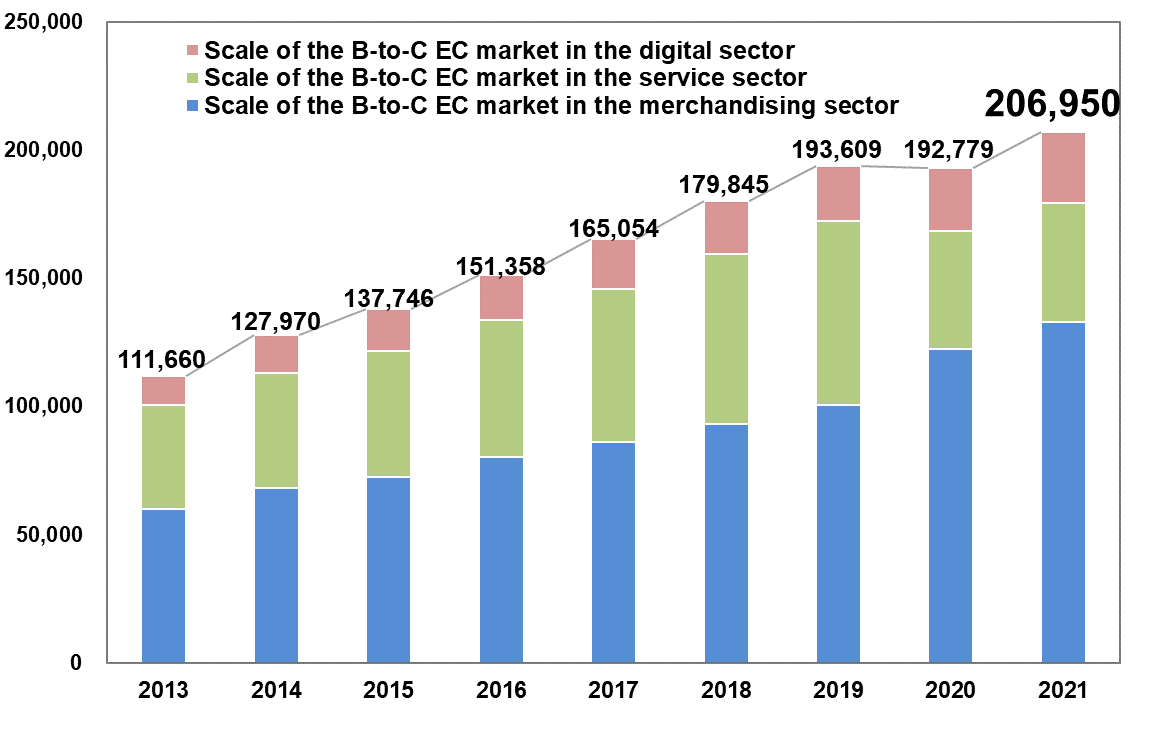
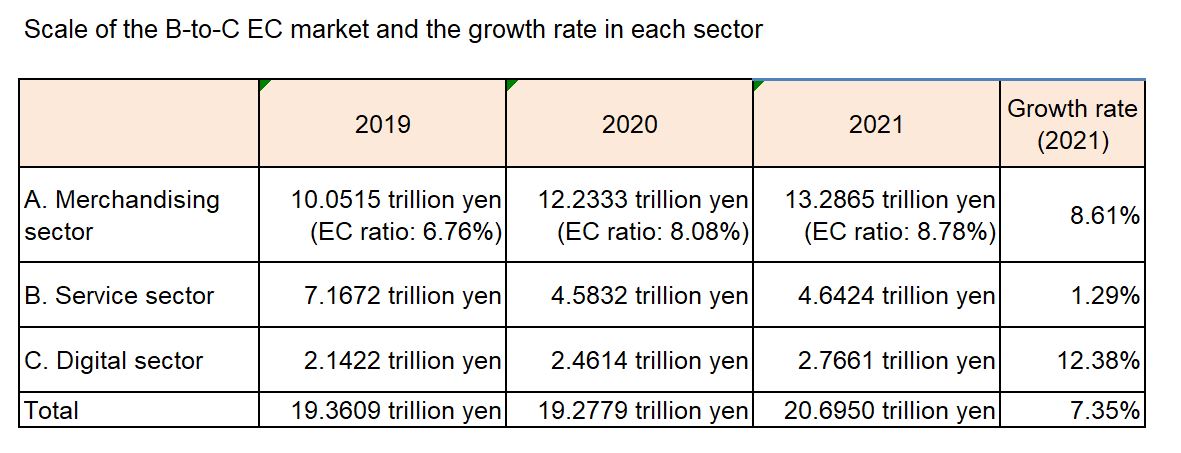
A. Merchandising sector
In the merchandising sector, "food, drinks, and liquor" (2.5199 trillion yen), "domestic electrical appliances, AV equipment, and PCs and peripherals" (2.4584 trillion yen), "clothes and apparel goods" (2.4279 trillion yen), and "household goods, furniture, and interiors" (2.2752 trillion yen) account for large shares. The total of these top four categories exceeds 2 trillion yen and accounts for 73% of the merchandising sector.
In addition, the scale of the B-to-C EC market in the merchandising sector expanded enormously in 2020 due to the impact of COVID-19 stay-home consumption, and continued to expand in 2021 despite the recovery in opportunities to go outside among consumers. This can be considered evidence that use of EC is gradually taking root among consumers. Although the size of the B-to-C EC market in the merchandising sector in 2021 expanded at a slower rate than in 2020, it still had a high growth rate, given that the amount of purchases for private consumption in Japan was largely flat.
The EC ratios were high for "books, and visual and music software" (46.20%), "domestic electrical appliances, AV equipment, and PCs and peripherals" (38.13%), and "household goods, furniture, and interiors" (28.25%).
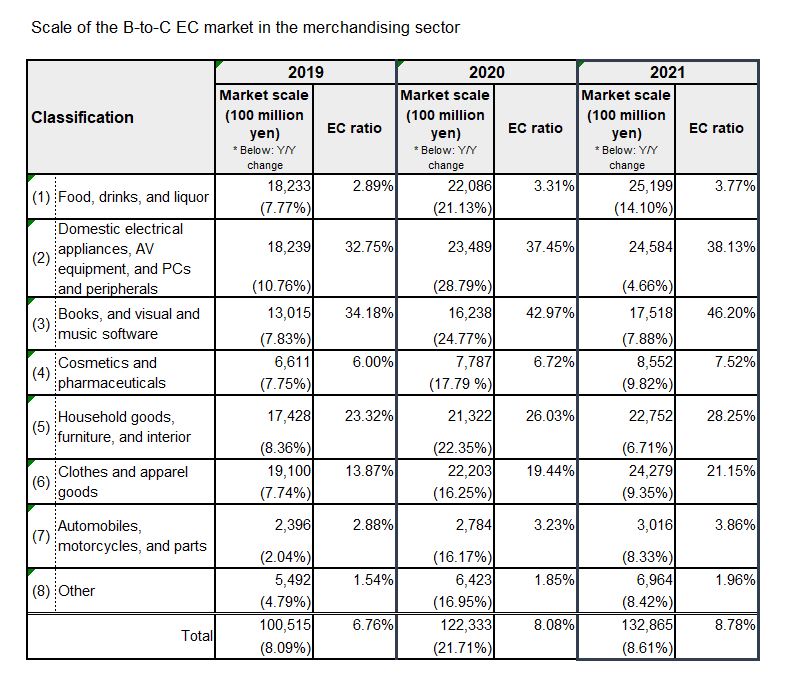
B. Service sector
In the service sector, "travel services" (1.4003 trillion yen) accounted for the largest share. Although the market scales of "travel services," "eating and drinking services," and "ticket sales" drastically decreased in 2020 compared to the previous year due to the COVID-19 pandemic, the market scale of "ticket sales" recovered in 2021.
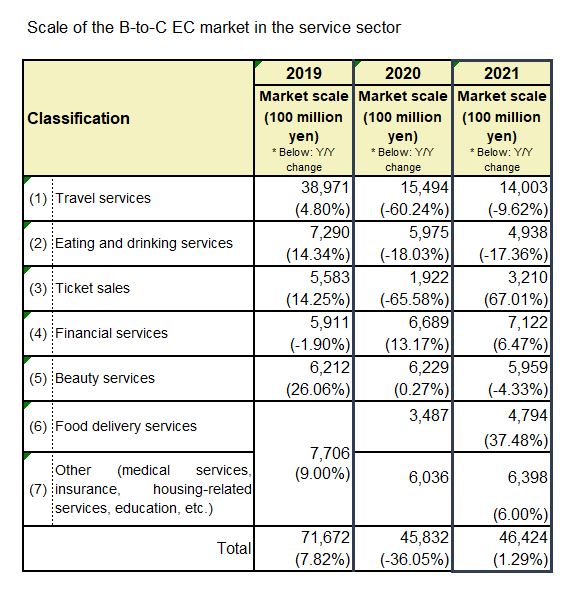
C. Digital sector
In the digital sector, "online games" (1.6127 trillion yen) accounted for the largest share. Although their growth rates have slowed compared to 2020, stay-home consumption due to the COVID-19 pandemic is thought to have been behind the expansion of the "online games," "paid video distribution," and "electronic publication (e-books and e-magazines)" markets.
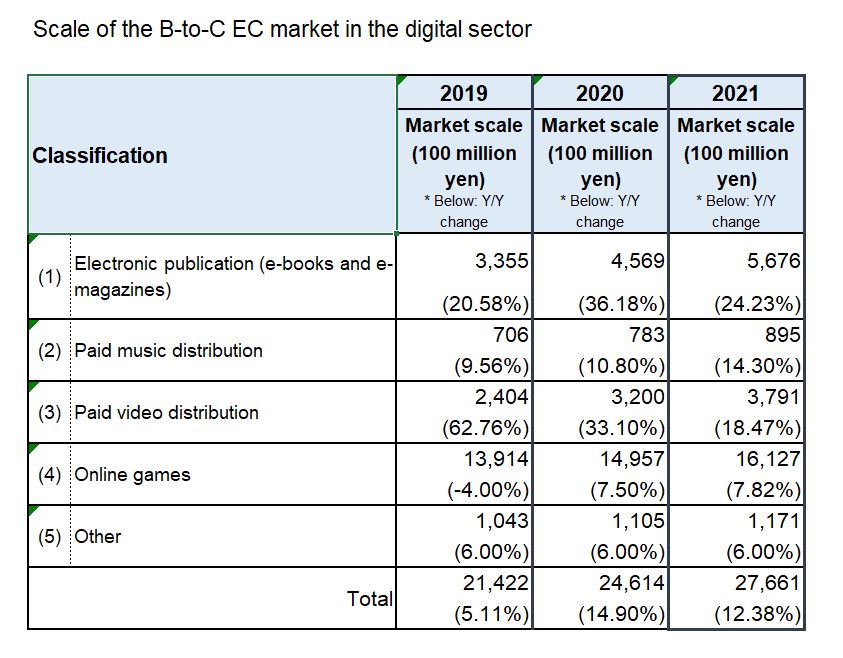
(2) Scale of the domestic EC market (consumer-to-consumer [C-to-C])
In recent years, the C-to-C EC market2 has been dramatically expanding as an EC channel. In light of this trend, METI has been estimating the scale of the market in Japan since the 2016 survey.
The scale of the C-to-C EC market in 2021 is estimated to be 2.2121 trillion yen (up by 12.9% from the previous year). As with the B-to-C EC market, one of the reasons posited to be behind the market scale expansion is that the COVID-19 pandemic caused an increase in purchases of items for indoor entertainment and hobbies.

(3) Market scale of cross-border EC between Japan, the U.S., and China
In 2021, the market scale of cross-border EC between Japan, the U.S., and China increased in all three countries. In particular, the amount purchased through cross-border EC by Chinese consumers was 2.1382 trillion yen from Japanese business operators (up by 9.7% from the previous year) and 2.5783 trillion yen from U.S. business operators (up by 11.5% from the previous year), continuing the previous year's increasing trends.
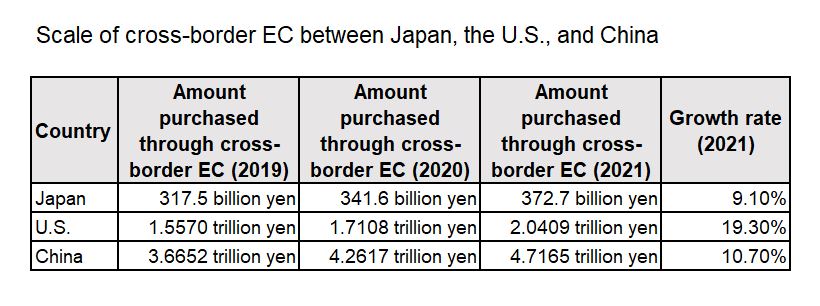
2. Outline of the E-Commerce Market Survey
This survey has been conducted every year since FY1998 with the aim of discovering the trends in the EC market and the current situation regarding its users. This was the 24th survey.
In addition to the domestic market scale of business-to-consumer, business-to-business and consumer-to-consumer EC, the survey has also been investigating the market trends in B-to-C cross-border EC (between Japan, the U.S., and China).
1. The EC ratio in this survey refers to the ratio of the e-commerce market scale to the total amount for all commercial transactions. The calculation for the EC ratios is based on merchandising businesses in the case of B-to-C EC, and on the business types not in the industrial classification category "Other" in the case of B-to-B EC.
See the document below for more details about the survey.
2. For C-to-C transactions, the survey does not only consider ones between individuals, but also includes B-to-B and B-to-C transactions, and the value for the market scale includes these as well.